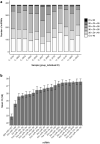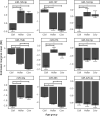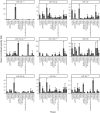Association of plasma miRNAs with early life performance and aging in dairy cattle
- PMID: 37428722
- PMCID: PMC10332601
- DOI: 10.1371/journal.pone.0288343
Association of plasma miRNAs with early life performance and aging in dairy cattle
Abstract
Early life performance traits in dairy cattle can have important influences on lifetime productivity. Poor health and fertility are of great economical and animal welfare concern. Circulating miRNAs have been linked to several livestock traits, including resistance to infection, fertility, and muscle development. This study aimed to identify circulating miRNAs associated with early life performance traits and aging in dairy cattle. Plasma samples from female calves (n = 12) identified retrospectively as differing in health, growth, and fertility outcomes prior to first calving were analyzed using PCR arrays detecting 378 miRNAs. Levels of 6 miRNAs differed significantly in calves with poor growth/fertility relative to controls (t-test: P<0.05). Additionally, general(ized) (non)linear mixed models identified 1 miRNA associated with average daily gain until weaning, 22 with live bodyweight at one year of age, 47 with age at first service, and 19 with number of infections before first calving. Out of 85 distinct miRNAs that were associated with at least one animal trait, 9 miRNAs were validated by RT-qPCR in a larger cohort (n = 91 animals), which included longitudinal plasma samples (calf, heifer, first lactation cow). Significant associations (P<0.05) involving individual miRNAs or ratios between miRNAs and early-life performance traits were identified, but did not retain significance after multiple testing adjustment. However, levels of 8 plasma miRNAs (miR-126-3p, miR-127, miR-142-5p, miR-154b, miR-27b, miR-30c-5p, miR-34a, miR-363) changed significantly with age, most prominently during the calf-to-heifer transition. Comparative RT-qPCR analyses of these miRNAs across 19 calf tissues showed that most were ubiquitously expressed. Online database mining identified several pathways involved in metabolism and cell signaling as putative biological targets of these miRNAs. These results suggest that miR-126-3p, miR-127, miR-142-5p, miR-154b, miR-27b, miR-30c-5p, miR-34a, miR-363 are involved in regulating growth and development from birth to first lactation (~2 years old) and could provide useful biomarkers of aging in cattle.
Copyright: © 2023 MacLeay et al. This is an open access article distributed under the terms of the Creative Commons Attribution License, which permits unrestricted use, distribution, and reproduction in any medium, provided the original author and source are credited.
Conflict of interest statement
The authors have declared that no competing interests exist.
Figures





Similar articles
-
Dairy cow performance is associated with longitudinal microRNA profiles.PLoS One. 2025 Aug 1;20(8):e0328765. doi: 10.1371/journal.pone.0328765. eCollection 2025. PLoS One. 2025. PMID: 40748909 Free PMC article.
-
Circulating MicroRNAs as Potential Molecular Biomarkers for Intracranial Aneurysmal Rupture.Mol Diagn Ther. 2020 Jun;24(3):351-364. doi: 10.1007/s40291-020-00465-8. Mol Diagn Ther. 2020. PMID: 32323261
-
Association of recurrent venous thromboembolism and circulating microRNAs.Clin Epigenetics. 2019 Feb 13;11(1):28. doi: 10.1186/s13148-019-0627-z. Clin Epigenetics. 2019. PMID: 30760335 Free PMC article.
-
Circulating microRNAs associated with gestational diabetes mellitus: useful biomarkers?J Endocrinol. 2022 Dec 13;256(1):e220170. doi: 10.1530/JOE-22-0170. Print 2023 Jan 1. J Endocrinol. 2022. PMID: 36346274 Review.
-
Circulating microRNAs as clinically useful biomarkers for Type 2 Diabetes Mellitus: miRNomics from bench to bedside.Transl Res. 2022 Sep;247:137-157. doi: 10.1016/j.trsl.2022.03.008. Epub 2022 Mar 27. Transl Res. 2022. PMID: 35351622 Review.
Cited by
-
Dairy cow performance is associated with longitudinal microRNA profiles.PLoS One. 2025 Aug 1;20(8):e0328765. doi: 10.1371/journal.pone.0328765. eCollection 2025. PLoS One. 2025. PMID: 40748909 Free PMC article.
References
-
- Macrae A, Esslemont R. Dairy Cattle Herd Health The Prevalence and Cost of Important Endemic Diseases and Fertility in Dairy Herds in the UK. In: Bovine Medicine. 2015. p. 325–37.
-
- Cooke JS, Cheng Z, Bourne NE, Wathes DC. Association between growth rates, age at first calving and subsequent fertility, milk production and survival in Holstein-Friesian heifers. Open J Anim Sci. 2013;03(01):1–12.
-
- Johnson K, Burn CC, Wathes DC. Rates and risk factors for contagious disease and mortality in young dairy heifers. CAB Rev Perspect Agric Vet Sci Nutr Nat Resour. 2011;6(August 2016):59.
-
- Miglior F, Chesnais J, Doormaal BJ Van, Food G, Canada A food, Network CD, et al. Genetic improvement: a major component of increased dairy farm profitability. In: 38th International Committee for Animal Recording. 2012. p. 1–13.
Publication types
MeSH terms
Substances
LinkOut - more resources
Full Text Sources

